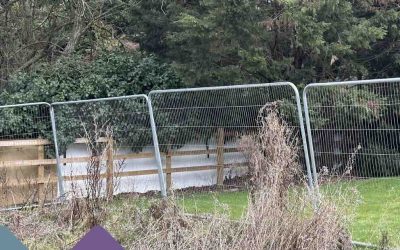Boundary fence issues and boundary disputes are unfortunately a common issue for property owners.
A boundary dispute will usually arise when one of the owners whose borders adjoin the land of another, has some form of issue, disagreement, or dispute in respect of the placement, location or plane of the boundary line.
Thank you for clicking on this week’s instalment of our Property Surveying blog, through our blog we aim to address and combat some of the more complicated and confusing areas of property surveying that our team of London based chartered surveyors deal with on a daily basis.
One of the most prevalent issues that we see here at Stokemont is boundary disputes.
Boundary disputes, while complicated, are also an incredibly stressful dispute for property owners to be a party to. Through this blog post and throughout our professional property surveying services, we aim to not only reduce the stresses that can come with property disputes. More importantly, we aim to reduce the complication and costs that can come with them.
Today, we are going to be looking at some of the typical or conventional boundary disputes that we have seen over the years. The hope being, that through reading this post, you are able to avoid some of these issues, or at the very least see the issue coming before it arises.
Neighbour Discussion
One of the most typical and repetitive issues that we see here at Stokemont is neighbour discussion, or in this case a lack of it.
When it comes to boundary surveying matters, if property owners reside at the specific property that is subject to dispute, this will significantly exasperate the emotional invested interest.
Properties often change hands and in many cases there can be instances where a new property owner purchases and buys their house, with a neighbour having been in-situ and residing there for a number of years prior.
This is the perfect mix for issue. Mainly because in many cases the historic lay of the land may have not always have been managed or set out in the way that the Land Registry Title plan, or conveyance plan set out and stipulate. This can quickly lead to an issue whereby a new owner, or even the existing owner of the neighbouring property, want to regularise the issue.
In this type of scenario, you have effectively got two differing points of views coming together.
The key advice that we would offer here at Stokemont is to open discussions with the adjoining neighbour to whom you share the boundary with at the earliest opportunity.
Try your best to remove the emotional connection and instead try and figure out the basis and logic behind the neighbouring owner’s position.
This would significantly aid resolution, and could go as far as to avoid the need for professional input from both boundary surveyors and solicitors alike.
Check Title Deeds and Conveyance Plans
The next bit of advice that we would offer here at Stokemont, is to ensure that before any decision or opinion is reached on a boundary matter, that both conveyance plans and Title plans should be carefully checked.
This doesn’t mean passing a cursory glance over the plans. Instead, it means that you should review both your plans, along with your neighbour’s.
This is going to give you a holistic understanding of the historic lay of the land. While also setting out the legal ownerships, or at the very least the intended legal ownerships in respect of the boundary.
We would also go so far to suggest at this stage you consider taking a boundary surveyor’s advice, this can be in the form of a boundary surveyor’s desktop review, setting out their position and opinion on what they have seen to date.
The important thing to note is that it is not uncommon for Title plans to be at scales which do not allow for informed measurement. Furthermore, attempting to scale measure a Title plan, is realistically not only going to give you inaccurate data, it is going to significantly skew any results or information that it churns out.
The best point of call when looking at plans are conveyance plans.
Conveyance plans are the more informed maps or plans that accompany property transactions.
They are likely to contain additional information above and beyond the Land Registry Title plan. In many cases that additional information being sound enough to shed the all important light on the dispute at hand.
Construction Works
Construction works are typical and something that as property owners we are all likely to plan at some stage of our lives and property ownership journey.
It is important to note that while your planned works are going to significantly change the way in which the property works for you, they are also going to significantly impact the neighbouring property.
We would therefore advise carefully considering your plans from the perspective of the neighbouring property, looking at not only the short term nuisance of them. However, also looking at the likely boundary interaction that is going to take place.
Typical example of this would be the construction of new walls up to or astride boundary lines.
These often come by the way of rear extensions, side extensions or front extensions.
It is not uncommon for neighbouring owners to take issue with the location and set out of such walls within both architectural and structural plans.
Jumping back to the first recommendation we had, discussion with your neighbour can go a significant way to thwart potential issues in this regard.
Professional Advice
If all else fails, and neighbourly discussions are fruitless, at that stage the only real option you have got is to consider professional input.
The important thing to note here is to get neutral and considered boundary surveyor’s advice.
This will not only ensure that you are going to get an arm’s length and reasonable opinion on the boundary matter.
It is also going to ensure that you are well placed to present the boundary surveyor’s advice and report to your neighbour.
If indeed the report is in your favour and agrees with your position on the boundary, it is important to look at this as the starting piece to the puzzle that is boundary dispute resolution.
Here at Stokemont, we would advise that you present the findings and report to your neighbour, in the hope that they can review, discuss and ultimately consider the findings from the perspective of the boundary surveyor that undertook and prepared them.
Boundary surveying matters are naturally going to be stressful. If indeed you have made a considered approach to resolve the matter, then at that stage and it has failed, then at that stage it is probably best to consider calling in the professionals.
If you would like to discuss your boundary surveying matters with our team of experienced and qualified building surveyors and boundary surveyors here at Stokemont, please feel free to give us a call today, you can also sent us an email, we will be more than happy to assist and advise you.




